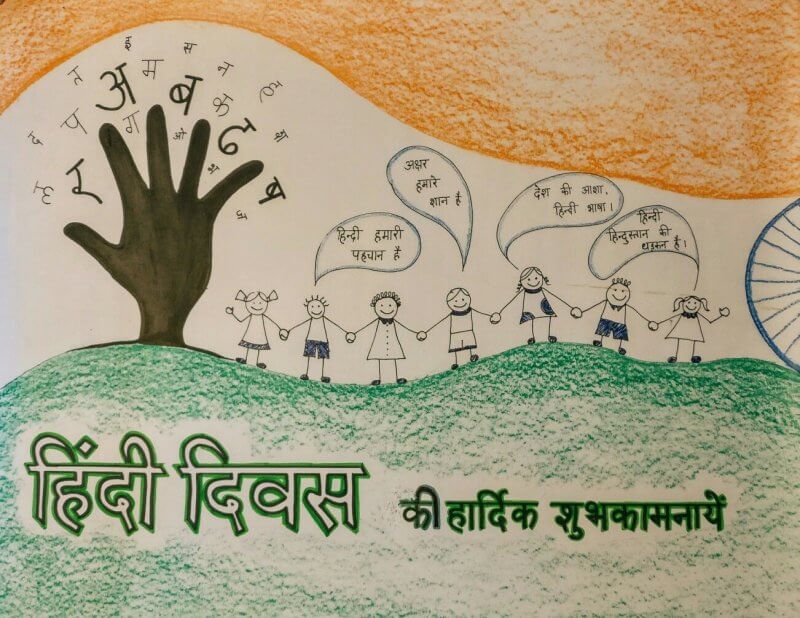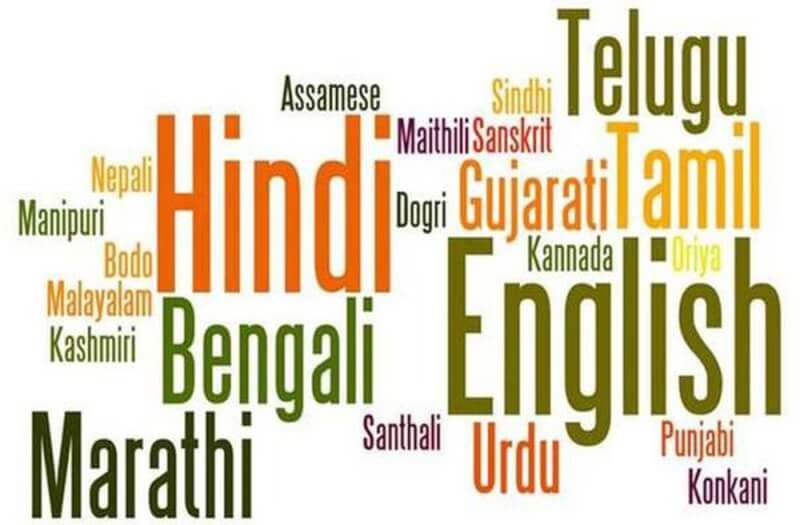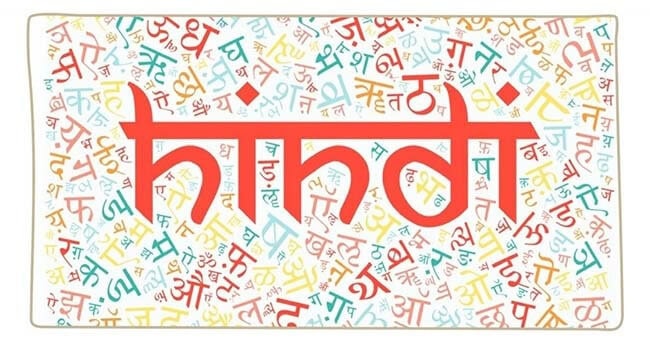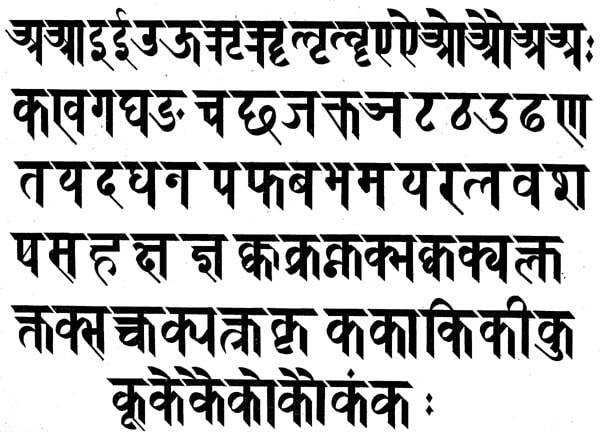Hindi language facts show that it is an old language with its own history and development period. Hindi, one of the languages spoken in India, belongs to the Indo-Urus family of languages like English. Today, it is the fourth most spoken language in the world, according to the 21st edition of Ethnologue. It is mainly spoken in four countries. About 341 million people speak Hindi as their first language. Overall, about 615,5 million people worldwide speak Hindi.
September 14 is considered Hindi Day or Hindi Divas, a special day to celebrate the adoption of Hindi written in the Devanagari script as the official language of India. The occasion marked 9 September 14, the 9th birthday of Beohar Rajendra Simha, a Hindi scholar who worked to push the language to become the official language of India. It was the same day when the Constituent Assembly of India approved the adoption of the language.

Hindi comes from Indo-European language family, while there are many languages spoken in India and they belong to different language families. The main languages are the Indo-Aryan and Dravidian languages, as well as the Austroasiatic, Tai-Kadai and Sino-Tibetan languages. The country ranks second after Papua New Guinea in the number of languages spoken.
Note: 05 Reasons You Should Translate And Localize Indian
India No National Language
The first interesting fact is that Hindi is not a national language. In fact, India has no national language, but Hindi and English are recognized as official languages. English is used by the government for administrative purposes. On the other hand, Hindi is a very popular language that many people think is the national language of India.
However, different states in India are allowed to choose between English and Hindi as official languages through legislation. The Constitution also recognizes 22 regional languages, including Hindi as an approved language. According to Ethnologue, the current list of languages in India includes 447 individual languages.

Regional Language
As of 2017, India is home to 1,39 billion people and given the size of the Indian subcontinent, it is not difficult to understand that a wide range of languages will be spoken in different regions. The most popular languages in the region are Telugu, Tamil, Urdu and Kannada.
Apart from regional languages, India has several immigrant languages, such as Arabic, Judeo-Iraqi Arabic, Rohingya, Iranian Persian, Chinese, Burushaski, Western Armenian and Uyghur.
Amazing Facts About the Hindi Language
If you are planning to learn Hindi, are interested in Indian history, or thinking of visiting India in the future, it is a good idea to know about the language of this country. The local language says more about the culture of the people. So here are some interesting facts about Hindi that you need to know:
1. Origin of Hindi
Hindi comes from the Hindustani language spoken in North India. It was standardized in the 19th century along with Urdu. These two languages have many similarities and many consider them to be variations of the original language, Hindustani.
2. Diversity of speakers
Hindi is a very popular language, being the fourth most spoken language in the world. The majority of Hindi speakers are found in the northern half of India. However, Hindi speakers can be found in Nepal, Trinidad and Tobago, Suriname, Guyana, Fiji, Mauritius and several other countries, including the United States and the United Kingdom.

3. Contributor to English Vocabulary
Among the many facts about the Hindi language, the most striking one is the huge amount of loanwords that this language has for English. Here are some of them.
- Avatar
- Bandanna
- Bangle
- Bungalow
- Cheetah
- Chutney
- Dinghy
- Dungaree
- Guru
- jodhpurs
- Khaki
- Mogul
- Maharaja
- Mantra
- Nirvana
- Punch
- Pajamas
- Wheels
- shampoo
- Thug
- Veranda
- Yoga
4. Different and unique sound
Hindi is easy to pronounce because each letter has its own unique sound. As a result, learners find it easy to pronounce words because they are spoken just like they are written, like Spanish.
Note: Price List for Spanish Translation
5. Hindi grammar can be difficult
For starters, it can be difficult to understand Hindi grammar as all nouns have gender. Therefore, the verbs and adjectives also change. However, there is no such thing as English, so you don't have to think about adding, "the" or "a", "an" when writing or speaking.
6. More letters than English
Hindi uses the Devanagari script, modeled after the Brāhmī script, an ancient script developed between the 1st and 4th centuries AD. It contains 11 vowels and 33 consonants. The Hindi alphabet is called Varnmala.
Note: Professional English Translation Price List
7. One of the hardest sentence structures to learn
When you construct a sentence in English, you usually follow the Subject-Verb-Subject or SOV structure. You can therefore use two nouns, with the first being the subject and the second being the subject of the verb. In Hindi, verbs and auxiliary verbs are placed at the end of a sentence. In English, you say, "How are you". In Hindi, it translates to "aap kaise hain". If you translated it word for word, it would be "you how are."

8. Hindi Of Persian Origin
Looking at the many interesting facts about Hindi, which is a language in India, you would have thought that its name comes from the country itself. However, its name comes from the classical Persian language. Its root word is “Hindī”, a Persian word translated into Indian derived from Hindi, meaning India, which is a proper noun. Hindi also translates to "Land of the Indus". The Indus River is one of the longest rivers in Asia. It originates in the Tibetan plateau and passes through India and into Pakistan and then flows into the Arabian Sea.
9. Hindi has many “firsts”
Some firsts make facts about Hindi language more interesting.
- As mentioned earlier, through legislation, countries in India can choose their own official language. The first state to do so was Bihar, which chose Hindi as the state's official language.
- The first record written in Hindi was a romantic play called Vik "Vikoorvashiyam in Apabhramsa". It was written in AD 400 by an Indian playwright, Kalidas.
- The first book in Hindi was published in 1805, with the title The Prem Sagur translated into Ocean of Love. It was written by Lallu Lal, an Indian scholar, translator, author and lecturer at Fort William College in Calcutta, where he teaches the Hindustani language.
- Hindi typewriters were first sold in 1930.
- The first weekly newspaper called Udanta Martanda published in Hindi appeared in 1826. It was published in Calcutta (now called Kolkata).
- In 1931, the first Hindi film with dialogue, called Alam Ara, was released in cinemas in India.
10. Combine Arabic and Persian words'
Most of the words in Hindi are borrowed from Persian and Arabic words. These loanwords enrich the Hindi language. More than 5.500 words in Hindi dictionary of Persian-Arabic origin.
Note: Prestigious Arabic translation price
11. Language of Unity
Mahatma Gandhi, a prominent political figure in India and famous as a freedom fighter, encouraged the use of Hindi as the lingua franca of India, the language of protest and the language of communication.
12. Different Variations
Spoken Hindi is not just a language. It has regional variations, like Standard Hindi, Nagari Hindi, Literary Hindi and High Hindi.
These are just some of the common facts about the Hindi language and there are some other interesting facts about the uniqueness of this language. Learning Hindi will make you appreciate Indian culture more. It is said that you can write anything in the language because there are no additional symbols that show the pronunciation of a word. Furthermore, Hindi letters do not produce mirror images that will give you other letters when they are reversed or upside down. This is in contrast to English letters like "b" and "d." “a” and e” or “w” and “m.”
Please Contact Us If You Need Hindi Translation
Are you doing business in India or have a collection of Indian literature that you would like to understand better in your language? With the variety of Hindi languages, you need to get the most accurate translation. The current Hindi translation service very few but the quality is not accurate. So please choose one for yourself Hindi translation company Professional - fast - quality at an affordable price.
Contact us today for the fastest service quote and consultation.
| ✔️ See more related information: | 👉 Reliable, Cheap, Professional Swedish Translation Chuyên |
| 👉 The Most Professional Electronic Translation | |
| 👉 Quick Translation of Seafood Documents | |

Nguyen Trung Khang - Talented interpreter and translator, passionate about translation
Nguyen Trung Khang is a talented interpreter and translator, with many years of experience in the field of translation and linguistics. He graduated from Ho Chi Minh City University of Education, majoring in Linguistics in 2015.
After graduating, Mr. Khang participated in a professional interpretation and interpretation training course at the University of Foreign Languages - Hanoi National University. He achieved a high-level certificate in interpreting and interpreting, and was also awarded a master's degree in linguistics.